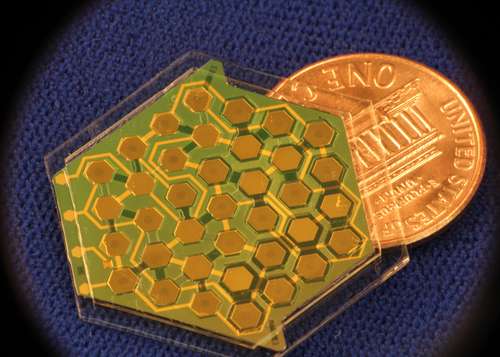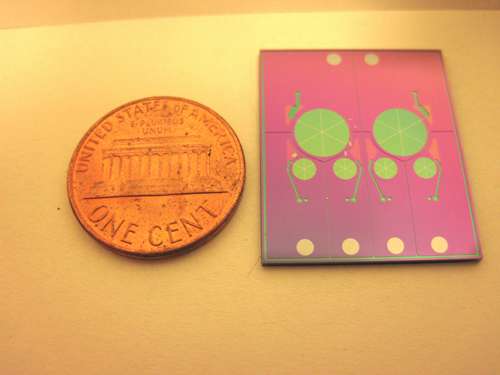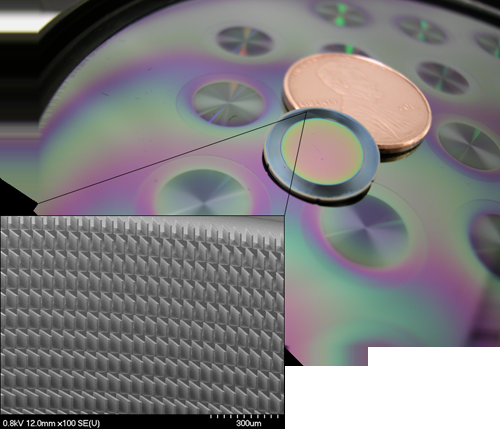Mighty micropumps: Small but powerful vacuum pumps demonstrated

DARPA-funded researchers recently demonstrated the world's smallest vacuum pumps. This breakthrough technology may create new national security applications for electronics and sensors that require a vacuum: highly sensitive gas analyzers that can detect chemical or biological attack, extremely accurate laser-cooled chip-scale atomic clocks and microscale vacuum tubes.
In 2008, DARPA's Chip-Scale Vacuum Micro Pumps (CSVMP) program set out to create a new class of ultra-high-performance vacuum micropumps. The program achieved an ultimate goal of a vacuum pressure of 10-6 Torr (1 Torr is 1/760 of 1 atmosphere) for a tiny 1 mm3 compartment with the smallest, most power-efficient pumps ever created.
"The process of creating a vacuum in a room large enough to test a spacecraft, for example, is pretty straightforward," said Andrei Shkel, DARPA program manager. "A sealed room, a large pump and ample power are all that is needed. That approach does not scale down to microscale vacuum chambers that are slightly larger than a grain of sand. We had to harness new kinds of physics to develop these pumps, requiring precision and miniaturization techniques that have never previously been attempted. The results are now available for future applications in the smallest, most sensitive electronics and sensors."
The program has reached a successful conclusion, and DARPA researchers at the University of Michigan; Honeywell International, Inc; and the Massachusetts Institute of Technology (MIT) demonstrated their pumps.

Researchers at the University of Michigan developed three different pumps in three different pressure categories. From lowest to highest pressure, the categories are microplasma Penning ion high vacuum, Knudsen mid vacuum, and high-frequency peristaltic rough vacuum pumps. Pictured above is a 24-stage microscale rough pump that uses tiny micromachined hexagonal compartments, where each element of the array is either a pump or a valve.
A team at the Massachusetts Institute of Technology (MIT) has also developed three types of microscale gas pumps. This photograph shows a two-stage rough pump with curved surfaces that displace large volumes of gas and uses two valves to limit backpressure. This novel pump was created by focusing on efficiency to create a compression ratio of 4.6 per stage—the highest recorded value at this scale.

Honeywell International, Inc. demonstrated a microfabricated, turbomolecular pump that operates in the mid-vacuum and high-vacuum range. The pump design is analogous to a turbine, but in reverse. The blades on the rotor are angled and push gas outward as they spin, creating a vacuum in the center. Each of the blades on the fan is about half the size of the period at the end of this sentence.
"There have never been ionic or mechanical gas pumps at the microscale before," said Shkel. "The CSVMP program has demonstrated both and more. The smallest commercially available pumps are the size of a deck of cards, which dwarf the vacuum electronics and sensors we want to attach our pumps to. These pumps are not only 300 times smaller than off-the-shelf pumps and 20 times smaller than custom-built pumps, but they also consume approximately 10 times less power to evacuate from atmospheric pressure to milliTorr pressures."
Initially, CSVMP focused on applications with small mass spectrometry gas analyzers, which would enable better chemical and biological pathogen detection. As the program continued to develop smaller and more powerful pumps that could create vacuums at different scales, other applications became apparent.
"These microscale gas pumps may ultimately be required for laser-cooled atomic clocks, accelerometers and gyroscopes," said Shkel. "Laser cooling systems require vacuums, but are often significantly smaller than the pumps themselves. It is possible that these pumps will help enable smaller, more accurate atomic clocks, like those currently being developed as part of the DARPA Integrated Micro Primary Atomic Clock Technology (IMPACT) effort or vacuum electronics being developed as part of the High Frequency Integrated Vacuum Electronics (HiFIVE) program."
Provided by DARPA



















